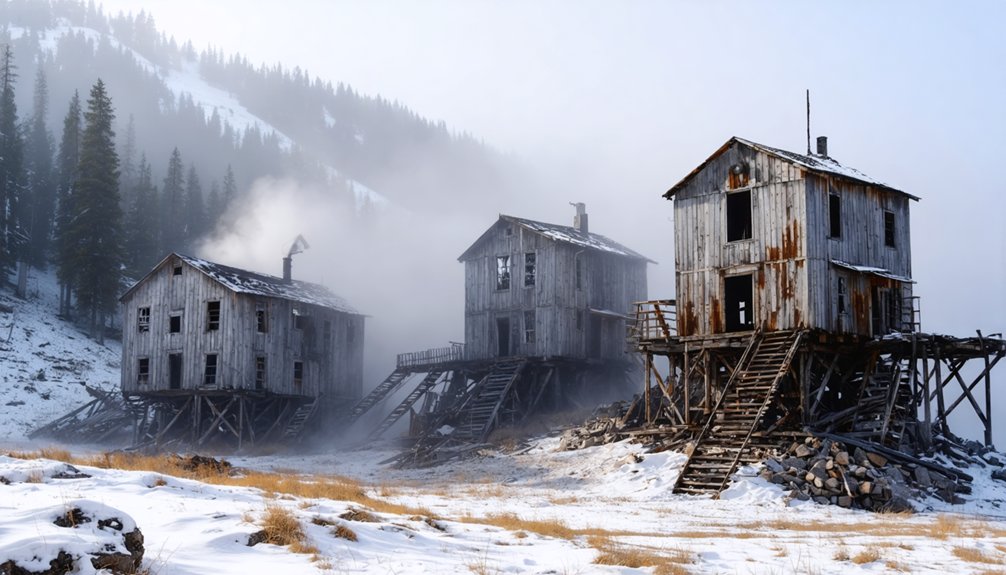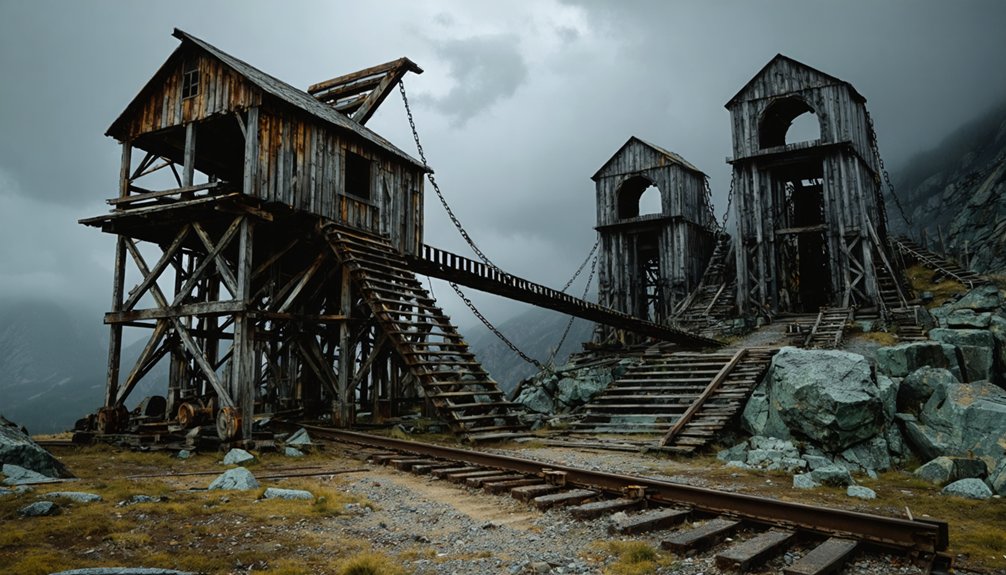You’ll discover Colorado’s most haunting ghost towns from the 1880s mining era scattered throughout the Rocky Mountains. St. Elmo’s 40 original structures, Animas Forks at 11,200 feet, and Ashcroft’s abandoned saloons tell tales of silver fortunes and sudden busts. These remote settlements once bustled with thousands of prospectors, complete with hotels, newspapers, and grand balls. Gothic’s transformation into a research station and Alta’s devastating fire remind us that each ghost town holds deeper secrets waiting to be revealed.
Key Takeaways
- St. Elmo Mining Camp preserves over 40 original 1880s structures at 10,000 feet, including its Town Hall museum and telegraph office.
- Animas Forks stands as one of America’s highest ghost towns at 11,200 feet, featuring nine preserved structures including the Duncan House.
- Ashcroft’s rapid rise and fall saw 2,000 residents, 20 saloons, and six hotels before silver depletion led to abandonment.
- Gothic transformed from a bustling mining town into a biological research laboratory, maintaining five original buildings from its 1880s heyday.
- Natural disasters shaped ghost towns’ fates, with avalanches, fires, and harsh winters forcing abandonment of numerous mining communities.
The Preserved Beauty of St. Elmo Mining Camp
Nestled at 10,000 feet in Colorado’s rugged mountains, St. Elmo stands as one of the state’s most authentic ghost towns, where you’ll discover over 40 original structures frozen in time since its 1880s mining heyday.
The St. Elmo architecture tells the story of a once-bustling community of 2,000 residents, featuring the preserved Town Hall museum, telegraph office, and the remarkable Iron City Cabin – a unique Queen Anne style log structure that defied typical mining camp design. Visitors should note that signs clearly indicate these historic buildings are private property.
While the 2002 fire claimed six historic buildings, preservation efforts have maintained the town’s raw authenticity. The town experienced several devastating fires in the 1890s that contributed to its eventual decline.
Today’s St. Elmo tourism lets you walk the same streets where miners once hauled gold, silver, and copper from over 150 patented claims, including the legendary Mary Murphy Mine that shipped up to 75 tons of ore daily.
Animas Forks: A High-Altitude Mountain Settlement
At a breathtaking 11,200 feet above sea level, Animas Forks earned its place as one of America’s highest ghost towns after prospectors discovered promising gold and silver deposits in 1873.
This high-altitude history transformed a remote mountain outpost into a thriving mining community of 450 residents by 1876. You’ll find the remnants of this once-bustling settlement 12 miles northeast of Silverton, accessible via the rugged Alpine Loop Scenic Byway.
In its heyday, you’d have encountered a complete mountain town with hotels, saloons, and even a newspaper. The town supported a vibrant community with a post office and jail. The extreme winters forced residents to migrate to nearby Silverton for survival.
Though the silver market crash of 1893 and a devastating fire hastened its decline, nine original structures still stand today, including the iconic Duncan House.
If you’re adventurous enough to tackle the four-wheel-drive terrain, you’ll discover one of Colorado’s best-preserved mining-era time capsules.
The Silver Rush Legacy of Ashcroft
During the early days of 1880, prospectors Charles B. Culver and W.F. Coxhead struck silver in Colorado’s Castle Creek Valley, igniting a rush that would transform Ashcroft into one of the West’s most promising boomtowns. The area’s native Ute people were displaced as mining operations expanded rapidly across the region. The Castle Creek Journal kept residents informed as one of two local newspapers documenting the town’s growth.
Within just three years, you’d have found yourself amid 2,000 residents, bustling streets, and silver mining claims yielding an astounding 14,000 ounces per ton.
By 1883, Ashcroft swelled with life as thousands flocked to streets where silver claims promised unimaginable wealth.
- Explore weathered remnants of 20 saloons and six hotels where miners once celebrated their fortunes
- Walk the same streets where H.A.W. Tabor, the silver king himself, hosted grand balls in 1883
- Witness how quickly fortune’s wheel turned as shallow veins led to the town’s dramatic decline
- Experience the town mythology that’s grown around Ashcroft’s dramatic rise and fall
- Discover preserved log cabins that tell tales of Western ambition and abandoned dreams
Gothic: From Mining Hub to Scientific Research Station
You’ll discover Gothic’s mining glory days in its surviving buildings, where silver fortunes were made and lost during the 1880s boom that drew notable figures like President Grant and investor Horace Tabor.
The town’s dramatic decline after the 1890s silver crash left it nearly abandoned, save for one determined resident who stayed behind for 15 years among the deteriorating structures. During its peak, the town boasted eight saloons and various businesses that served its thousand residents.
Today, you can explore Gothic’s remarkable transformation from a bustling mining settlement into the Rocky Mountain Biological Laboratory, where scientists have conducted alpine research since 1928 amid the preserved remnants of its frontier past. The discovery of valuable minerals including ruby silver and galena sparked the town’s initial growth into a thriving mining community.
Mining Glory Days
- Miners struck valuable deposits, sparking an immediate rush to the area.
- The town incorporated quickly, sprouting up at East River and Copper Creek.
- You’d find all the essentials: saloons, boarding houses, and supply stores.
- The settlement grew in terraced layers against the mountain backdrop.
- Daily life centered around the mines, with workers laboring for silver riches.
- Two-story business houses with prominent facades lined the carefully planned streets
- Eight saloons featured decorative woodwork and welcoming storefronts
- Local timber and stone construction guaranteed durability against harsh mountain conditions
- The historic dance hall and newspaper office served as vibrant community hubs
- Simple yet sturdy structures reflect the practical mindset of frontier mining communities
- The San Juan Mountains’ treacherous avalanches buried entire towns and cut off essential supply routes.
- Brutal winters forced the abandonment of Independence in 1899, when residents fled on handmade skis.
- Fire devoured vulnerable wooden structures, destroying communities in mere hours.
- Spring floods washed away remnants of once-thriving settlements.
- High-elevation towns like Animas Forks endured months of isolation, battling nature’s fury at 11,200 feet.
- Towns emerged overnight when rich mineral deposits were discovered
- Communities thrived while mines produced, building infrastructure and wealth
- The 1893 Sherman Silver Purchase Act repeal devastated silver-based economies
- Banks failed as property values plummeted, forcing mass exodus
- Some towns adapted to survive, while others became abandoned relics
- Experience guided Jeep tours through high-elevation mining camps
- Discover museums and interpretive centers showcasing authentic artifacts
- Photograph century-old structures while respecting preservation guidelines
- Join volunteer restoration projects to support local preservation efforts
- Navigate remote locations with 4-wheel-drive vehicles or hiking trails
- Bodie, California stands frozen in time with over 65 former saloons and personal belongings left exactly as they were, protected by its legendary curse.
- Centralia, Pennsylvania smolders with underground fires that have burned since 1962, creating an apocalyptic landscape.
- Virginia City, Nevada preserves the opulent legacy of the Comstock Lode silver strike.
- Bannack, Montana embodies the lawless frontier with tales of notorious bandits and stagecoach robberies.
- Batsto Village, New Jersey offers a rare glimpse into colonial industry amid stories of the Jersey Devil.
- https://kids.kiddle.co/List_of_ghost_towns_in_Colorado
- https://kekbfm.com/colorado-ghost-towns-a-z/
- https://en.wikipedia.org/wiki/List_of_ghost_towns_in_Colorado
- https://www.youtube.com/watch?v=SXVTtQjK8lU
- https://303magazine.com/2024/05/where-history-sleeps-colorado-ghost-towns/
- https://www.youtube.com/watch?v=MjydXUk0dOo
- https://thedyrt.com/magazine/local/colorado-ghost-towns/
- https://kekbfm.com/colorado-most-popular-ghost-towns/
- https://www.uncovercolorado.com/ghost-towns/
- https://www.westword.com/arts-culture/get-outside-ten-colorado-ghost-towns-15252895/
Like many Colorado towns that emerged during this era, tent cities formed initially before more permanent structures were built.
Due to the harsh winter climate, many miners could only work the claims seasonally before having to abandon their operations.
Modern Scientific Legacy
While silver mines fell silent across Gothic in the early 1900s, a new kind of treasure emerged from this mountain settlement. The Rocky Mountain Biological Laboratory transformed this abandoned boomtown into a thriving hub for ecological research in 1928, breathing fresh life into the historic buildings that once housed miners.
Today, you’ll find scientists instead of prospectors, seeking scientific breakthroughs in one of Earth’s most pristine high-altitude environments. From tracking hummingbird behavior to studying climate change impacts, over 9,000 researchers have conducted groundbreaking studies here.
The lab’s protected status through a conservation easement guarantees you’re witnessing living history – where original 1800s structures now shelter modern scientific discoveries. Gothic stands as a symbol of transformation, where yesterday’s ghost town fuels tomorrow’s environmental understanding.
Preserved Mountain Architecture
During Gothic’s peak in 1881, the town’s architectural ambitions soared with over 400 buildings dotting the mountain landscape.
You’ll find that Main Street once bustled with 80 substantial business houses, while practical log cabins and frame structures housed the town’s adventurous residents.
Today, architectural preservation efforts sustain five original buildings from Gothic’s mining heritage, offering you a glimpse into Colorado’s rugged past.
Life and Death in Alta’s Gold Fields
Perched at a breathtaking 11,800 feet above sea level, Alta emerged as one of Colorado’s highest mining settlements when prospectors Pat Cullen, Frank Dimik, and Thomas Knott discovered its rich gold veins in 1877.
Alta mining quickly evolved from surface-level operations, where you’d find miners bagging ore and loading mules, to a sophisticated enterprise featuring aerial tramways and electric power – a first for mining towns, thanks to Tesla and Westinghouse’s innovations.
Life in this mountain community meant adapting to brutal winters and embracing communal living in the town’s boardinghouse.
Survival at Alta demanded resilience, as residents huddled together in boardinghouses, finding warmth and companionship against fierce mountain winters.
You’d find several hundred residents braving the elements, relying on stagecoach lines for supplies and each other for survival.
The boom lasted until 1948, when a devastating fire in the snow shed brought Alta’s golden era to an abrupt end.
Natural Disasters That Shaped Colorado’s Ghost Towns
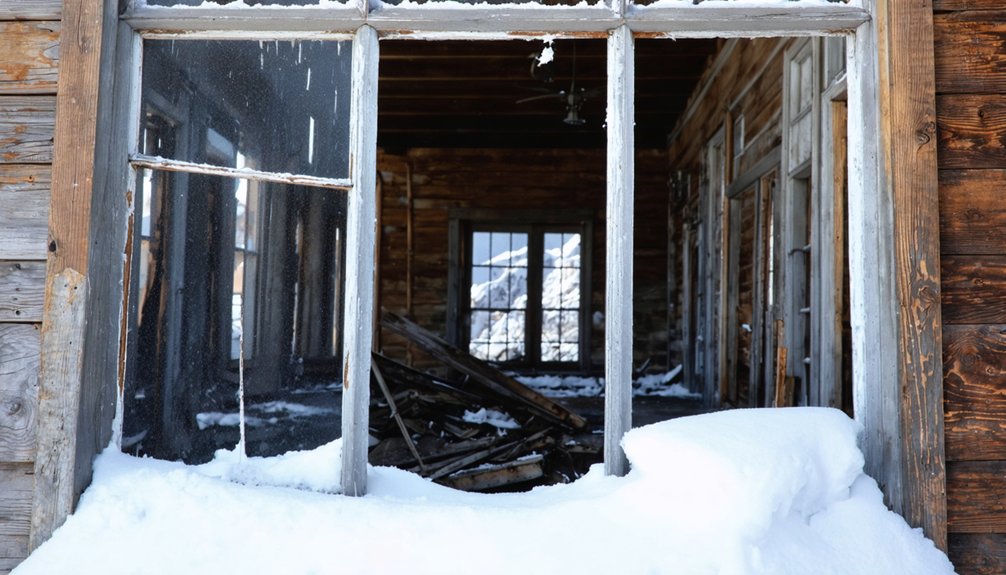
As early pioneers ventured into Colorado’s rugged mountain terrain, they couldn’t have predicted how nature would ultimately reclaim their settlements. Natural disasters became relentless adversaries, testing ghost town resilience at every turn.
From the devastating 1884 avalanche that buried Woodstock to the record-breaking blizzard of 1913, these forces shaped the fate of countless mining communities.
The Economic Rise and Fall of Mining Communities
When you look at Colorado’s mining towns of the 1860s and 1870s, you’ll find dramatic population swings that mirror the boom-and-bust cycles of mineral strikes.
You’d see a town like Central City explode from a handful of prospectors to 10,000 residents within months of a major gold discovery, only to witness its streets empty just as quickly when the ore ran dry.
These rapid economic shifts weren’t limited to single locations – as miners abandoned depleted claims, they’d rush to the next promising strike, creating a wave of instant cities and ghost towns across Colorado’s mountain landscape.
Boom-to-Bust Mining Cycles
During the late 1870s, Colorado’s mining communities experienced dramatic transformations that would define the state’s economic destiny.
You’ll find that mining heritage shaped entire towns like Leadville, where populations exploded from 200 to 15,000 in just two years.
These communities’ economic resilience was tested through cycles of prosperity and decline, driven by silver prices and federal policies.
The boom-and-bust pattern left an indelible mark on Colorado’s landscape, transforming bustling communities into ghost towns that still stand today.
Gold Rush Population Shifts
The discovery of gold near Pikes Peak in 1859 sparked one of America’s most dramatic population shifts, transforming Colorado’s rugged terrain into a patchwork of bustling boomtowns.
You’d have witnessed waves of prospectors flooding into hastily established settlements like Montana City and Idaho Springs, driven by dreams of striking it rich.
The population dynamics of these mining communities proved highly volatile. Within weeks of a major strike, you could find yourself among thousands of fortune seekers in places like Gregory’s Gulch, dubbed the “Richest Square Mile on Earth.”
Yet this transient workforce rarely put down permanent roots. Once the accessible gold ran out, towns emptied as quickly as they’d filled.
Only settlements that developed diverse economies or successfully adapted to deep-lode mining, like Breckenridge, managed to avoid becoming ghost towns.
Ghost Town Tourism and Preservation Efforts
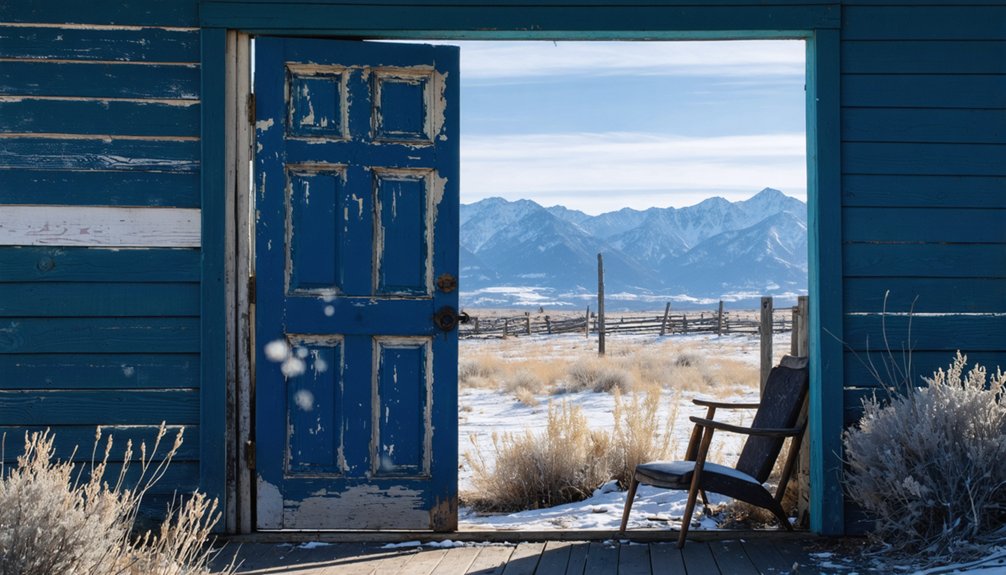
Throughout the late 20th century, Colorado’s ghost towns have transformed from forgotten relics into thriving tourist destinations, drawing visitors fascinated by the American West’s rich mining heritage.
As you explore these time-capsules of frontier life, you’ll find preservation challenges ranging from harsh mountain weather to structural deterioration. Tourism sustainability has become essential as over 640 ghost towns balance visitor access with historical protection.
Today’s ghost town tourism merges outdoor adventure with historical exploration, offering you a glimpse into Colorado’s rugged mining era while supporting local economies and conservation initiatives.
Hidden Gems: Lesser-Known Abandoned Towns
Beyond Colorado’s famous ghost towns lie dozens of hidden treasures waiting to be discovered in remote valleys and forgotten mountain passes.
Venture off the beaten path to uncover Colorado’s secret ghost towns, where untold stories await in secluded mountain valleys.
You’ll find forgotten histories in places like Teller City, where thirty saloons once served silver miners in the 1880s, and Dearfield, a unique African American agricultural settlement that tells a different story from the typical mining narrative.
For a true off-the-beaten-path experience, venture to Hancock at 11,054 feet, where minimal structures survive from its railroad heyday, or explore Hamilton’s vanished placer gold camp that thrived from 1860 to 1881.
These lesser-known sites often lack the tourist amenities of their famous counterparts, but they offer authentic glimpses into Colorado’s past through scattered cabin remains, old foundations, and artifacts that whisper tales of boom-and-bust cycles.
America’s Most Famous Ghost Towns Beyond Colorado
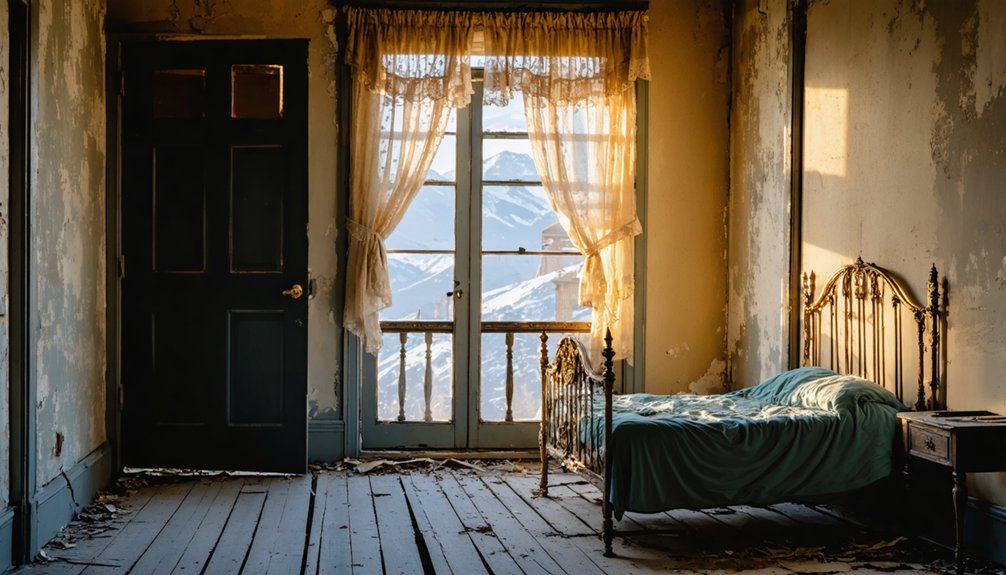
While Colorado claims many of America’s most famous ghost towns, remarkable abandoned settlements dot the landscape from coast to coast, each telling unique stories of boom-and-bust cycles that shaped the nation.
From mysterious legends of curses in Bodie to the eternal flames beneath Centralia’s streets, these haunting remnants of historical significance capture the untamed spirit of American expansion.
Frequently Asked Questions
Are There Documented Paranormal Activities in Colorado’s Ghost Towns?
You’ll find extensive ghost sightings in Colorado’s mining towns, especially Cripple Creek and Central City, where paranormal investigations regularly document apparitions, unexplained sounds, moving objects, and mysterious figures in period clothing.
What Survival Gear Should Visitors Bring When Exploring Remote Ghost Towns?
You’ll need survival essentials like sturdy boots, warm layers, first aid supplies, flashlights, maps, compass, multi-tool, and plenty of water. Don’t forget hiking safety gear for remote terrain.
Can You Legally Collect Artifacts From Abandoned Ghost Town Buildings?
Preserving precious pieces means you can’t collect artifacts without permits on public lands or landowner permission on private property. Legal implications include hefty fines and prosecution for unauthorized removal of historic items.
Which Ghost Towns Are Accessible During Winter Months?
You’ll find winter accessibility at Ashcroft, Saint Elmo, and Gold Hill ghost towns. Pack your AWD vehicle or snowshoes – these preserved mining settlements offer unique ghost town tours through snowy landscapes.
Do Any Ghost Towns Still Have Active Mining Claims?
You’ll find active mining claims in Victor, Lake City, and Gold Hill, continuing Colorado’s rich mining history. These ghost towns maintain working mines while preserving their historic character from the 1800s.

